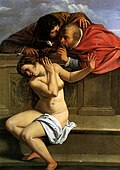Portal:Nudity
Introduction

Nudity is the state of being in which a human is without clothing. While estimates vary, for the first 90,000 years of pre-history, anatomically modern humans were naked, having lost their body hair, living in hospitable climates, and not having developed the crafts needed to make clothing.
As humans became behaviorally modern, body adornments such as jewelry, tattoos, body paint and scarification became part of non-verbal communications, indicating a person's social and individual characteristics. Indigenous peoples in warm climates used clothing for decorative, symbolic or ceremonial purposes but were often nude, having neither the need to protect the body from the elements nor any conception of nakedness being shameful. In many societies, both ancient and contemporary, children might be naked until the beginning of puberty and women often do not cover their breasts due to the association with nursing babies more than with sexuality.
In the ancient civilizations of the Mediterranean, from Mesopotamia to the Roman Empire, proper attire was required to maintain social standing. The majority might possess a single piece of cloth that was wrapped or tied to cover the lower body; slaves might be naked. However, through much of Western history until the modern era, people of any status were also unclothed by necessity or convenience when engaged in labor and athletics; or when bathing or swimming. Such functional nudity occurred in groups that were usually, but not always, segregated by sex. Although improper dress might be socially embarrassing, the association of nudity with sin regarding sexuality began with Judeo-Christian societies, spreading through Europe in the post-classical period. Traditional clothing in temperate regions worldwide also reflect concerns for maintaining social status and order, as well as by necessity due to the colder climate. However, societies such as Japan and Finland maintain traditions of communal nudity based upon the use of baths and saunas that provided alternatives to sexualization. (Full article...)
Selected general article

Freikörperkultur (FKK), meaning 'free body culture', is a social and health culture that originated in the German Empire, with its beginnings historically rooted in the Lebensreform social movement of the late 19th century. It promotes the health benefits of nudity—such as exposure to light, air, and sun—alongside a broader aim to reform life and society. Freikörperkultur shares cultural and philosophical ties with naturism and nudism, which involve communal nudity among individuals and families during leisure time, sports, and everyday life.
By the 20th century, recognised for its public health benefits, the practice of communal open-air nudity became increasingly visible in the German cultural sphere, shaped by growing interest in nature, hygiene, and overall wellbeing. This cultural emergence was partly a response to the lifestyle pressures of industrialised urban society, with advocates viewing nudity in natural environments as a restorative contrast to the alienation of modern city life. Public health reformers and Lebensreform adherents championed regular exposure to light, air, and sun—not merely as medical advice, but as a philosophical gesture toward vitality, simplicity, mental relaxation, and social renewal. Today, there are only a few legal restrictions on public nudity in Germany. Under the terms 'naturism' and 'nudism', it is now internationally widespread, with associations and designated public spaces in numerous countries in Europe, North and South America, Australia, Africa, Asia, and the Caribbean. The greatest concentration remains in Central Europe and Scandinavia. (Full article...)
Did you know...
- ... that the runway show for Scanners by Alexander McQueen concluded with a mostly nude model struggling through an artificial snowstorm in a wind tunnel?
- ... that Will Wood performed nude for the music video of a song on SELF-iSH?
- ... that a nude painting of a Mexican revolutionary is housed at the Museum of Forbidden Art in Spain?
- ... that film critic and censor D. I. Suchianu wanted Romanian moviegoers to cease "falling asleep whenever they're not shown a naked breast [or] a hip that's getting some action"?
- ... that after women's suffrage in Switzerland was approved in a referendum in 1971, the tabloid Blick sported a cover with a naked blonde and the headline "Thank you for the Roses"?
- ... that Susanna Hoffs sang on the studio recording of "Eternal Flame" naked after producer Davitt Sigerson pranked her by saying that Olivia Newton-John had done the same thing?
- ... that vampire amoebae are naked?
- ... that the Indian politician Diwan Chaman Lall failed to get rid of the painting Nude of Indira?
Need help?
Do you have a question about Nudity that you can't find the answer to?
Consider asking it at the Wikipedia reference desk.
Get involved
For editor resources and to collaborate with other editors on improving Wikipedia's Nudity-related articles, see WikiProject Nudity.
Subtopics
Associated Wikimedia
The following Wikimedia Foundation sister projects provide more on this subject:
-
Commons
Free media repository -
Wikibooks
Free textbooks and manuals -
Wikidata
Free knowledge base -
Wikinews
Free-content news -
Wikiquote
Collection of quotations -
Wikisource
Free-content library -
Wikiversity
Free learning tools -
Wiktionary
Dictionary and thesaurus






























































